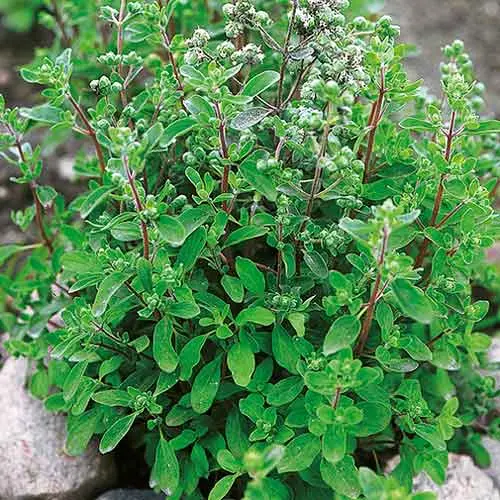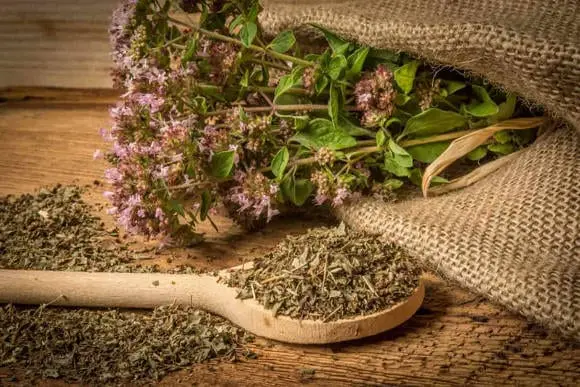Contents
Description
Meet the spices oregano (lat. Origanum Vulgare), known in our area as oregano, as well as motherboard, incense, and zenovka.
The name oregano comes from the Greek oros – mountain, ganos – joy, i.e. “Joy of the mountains” because oregano comes from the rocky shores of the Mediterranean.
Description of the spice oregano
Oregano or Oregano ordinary (lat.Origanum vulgare) is a species of perennial herbaceous plants from the genus Oregano of the family Lamiaceae.
A spicy-aromatic plant, the homeland of which is considered to be Southern Europe and the Mediterranean countries. In Russia, it grows everywhere (with the exception of the Far North): forest edges, roadsides, river floodplains, and hillsides are considered oregano’s favorite places.
The plant, known to the ancient Greeks and Romans, was used as a herb, added to food, and also as a means to improve the aroma of baths, fragrant waters, and destroy various microbes.

It is believed that the most fragrant oregano grows on the limestone rocks of sunny Italy. Found in the wild in Italy, Mexico, Russia. Oregano is cultivated in Spain, France, Italy, Greece, America.
Oregano is subdivided into subspecies according to odor: Origanum creticum, Origanum smyrneum, Origanum onites (Greece, Asia Minor) and Origanum heracleoticum (Italy, Balkan Peninsula, Western Asia). A close relative of oregano is marjoram, which, however, tastes different due to the phenolic composition in essential oils. They should not be confused.
There is also Mexican oregano, but this is a completely different plant and should not be confused. Mexican oregano comes from the Lippia graveolens family (Verbenaceae) and is close to lemon verbena. Although little related to the original, Mexican oregano presents a very similar scent, slightly stronger than European oregano.
It is exclusively represented in the USA and Mexico. The taste is spicy, warm and slightly bitter. The height of oregano plants reaches 50-70 cm. Rhizome is branched, often creeping. The stem of oregano is tetrahedral, erect, softly pubescent, branched in the upper part.

Leaves are opposite petiolate, oblong-ovate, whole-edged, pointed at the apex, 1-4 cm long.
Flowers are white or red, small and numerous, collected in paniculate inflorescences. Oregano blooms in June-July, starting from the second year of life. The seeds ripen in August. Oregano is not demanding on the soil, prefers open areas.
Oregano is harvested during mass flowering, starting from the second year of the growing season. Plants are cut at a height of 15–20 cm from the soil surface so that the collected green mass contains a minimum number of stems.
What does oregano look like
Oregano reaches 70 centimeters in height. The stem of the plant is straight, thin, branched. The leaves are green, small, drop-shaped. Inflorescences are formed to the top of the stem. Oregano blooms in June-July. The flowers are small, pink-lilac in color, located in the axils of the upper and lateral inflorescences.
When oregano blooms, a light, pleasant scent spreads around. The plant grows brightly and densely, and it is simply impossible not to notice the soft purple, lush umbrellas against the background of greening nature!
How the oregano spice is made

To obtain the spice, oregano is dried under a canopy, in attics, in well-ventilated rooms or in a dryer at a temperature not exceeding 30-40 ° C.
The essential oil obtained from oregano is colorless or yellowish, conveys the smell of raw materials well, has a pungent taste. Oregano is a good honey plant. Turkey is currently one of the main suppliers and consumers of oregano.
History of the spice
The first mention of the fragrant oregano plant dates back to the 1st century AD. The Greek scientist Dioscoridos, in the third volume of his great work “Peri hyles jatrikes” (“Medicinal plants”), devoted to herbs, roots and their healing properties, mentions oregano.
Roman gourmet Tselius Apicius compiled a list of dishes that were consumed by the noble Romans. They included a significant number of herbs, among which he distinguished thyme, oregano and caraway. Oregano has spread to the countries of Northern and Western Europe, Asia, Africa, America.
Benefits of oregano

Oregano contains essential oils: carvacrol, thymol, terpenes; ascorbic acid, tannins, vitamins and minerals. Oregano has bactericidal and disinfectant properties.
Oregano helps with coughs, bronchial asthma and bronchitis, inflammation of the respiratory tract, tuberculosis; as a diaphoretic and diuretic. It is used for rheumatism, cramps and migraines, as well as bloating, loss of appetite, diarrhea, jaundice and other liver diseases.
Has a sedative effect on the central nervous system, as a mild hypnotic and sedative with a strong sexual desire. Accelerates wound healing and relieves toothache. Baths with oregano soothe and relieve pain, and are also used for scrofula and rashes.
In ancient times, doctors recommended oregano for headaches. Also, this plant acts on the liver, helps with poisoning.
In the perfumery and cosmetic industry, oregano essential oil is used in the manufacture of soaps, colognes, toothpastes, lipsticks.
Contraindications
Oregano also has contraindications – not everyone will benefit from using the plant as a medicine or spice. Oregano should not be used categorically:
- during pregnancy (has a stimulating effect on the smooth muscles of the uterus, which increases the risk of miscarriage and premature birth);
- with ulcers of the stomach and duodenum;
- with gastritis with high acidity of gastric juice.
- Caution for men: prolonged or excessive use of the spice can provoke the development of erectile dysfunction.
- Do not use oregano as a seasoning for children under 3 years of age, due to the risk of allergic reactions.









